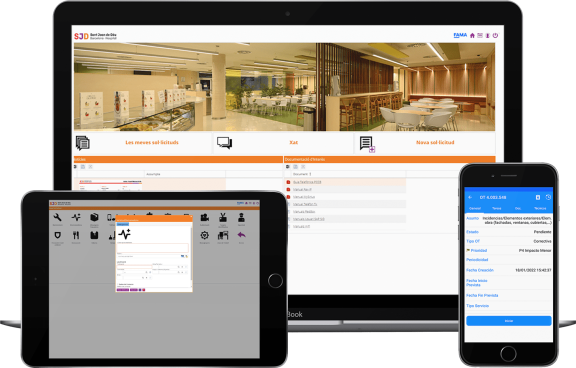After my participation in the Digital Health conference: digital services, interoperability, and data analysis, organized by Socinfo Digital, I realized that most of the attendees did not take into account that the management of facilities is fundamental to provide a high level of patient care. In fact, when everything works, this management is invisible, but when there are problems and it is not managed properly, it fully affects the quality of care, as well as entailing an economic cost. Both public and private entities must understand that they cannot neglect the management of their facilities. And whatever the type of infrastructure, software solutions improve this management through these four objectives:
At FAMA, with more than 25 years of experience as a technological partner in the comprehensive management of assets and infrastructures of numerous organizations, we have detected the main challenges that healthcare infrastructure managers must face and the benefits that the use of centralized and comprehensive platforms can have.
Challenges related to sanitary facilities management
Undoubtedly, the representatives of a healthcare organization must face multiple challenges when it comes to managing the buildings and services in order to offer the best healthcare. Facility Management must coordinate everything from space management to maintenance and cleaning, including the way it is used by various users, both staff and patients. And also, the great challenge is to make this complex work, which integrates multiple areas, as simply as possible. Below we list some of the questions that organizations should ask themselves to find out whether or not they are managing a facility properly.
Integral and centralized management thanks to technology
Certainly, solutions enabling the controlled, automated, and centralized management of all buildings and facilities within a healthcare organization present a transformative scenario. Here are the four main benefits of this digital transformation:
1. Provision of a classified inventory
The organization benefits from dashboards that offer comprehensive insights, showcasing detailed expenditure per property. It ensures easy verification of work conformity by suppliers, enabling accurate payments and providing meticulous control over any budget deviations, particularly in instances involving construction or renovations.


2. Agility in communication and incident resolution
These platforms significantly enhance incident communication times among users, installation managers, and suppliers, thereby expediting issue resolution. The organization gains full visibility into factors like incident status, corrective maintenance costs, and the recurrence of specific services. This foresight allows the organization to proactively direct investments to specific areas. Importantly, in case of a change in suppliers during the next tender, data continuity is ensured as the platform seamlessly transitions to support the next successful bidder, preventing data loss.
3. Automation of sustainability management
Automatically, the platform enables monitoring and insights into various sustainability aspects, including indicators such as carbon footprint and reports on waste generation by type. The system also streamlines the management of quality and environmental standards, providing visibility into the evolution of electricity consumption across all managed spaces.

4. Real-time control and management of documentation and processes related to occupational risks
Technology streamlines the coordination and validation of occupational risk prevention and business activity coordination aspects, particularly concerning external service personnel accessing the facilities. Contractors receive a QR code that enables them to check whether they are compliant with their obligations related to occupational risk prevention, training, provision of personal protective equipment (PPE), and more.

Interoperability in the e-Health Strategy
All of this is also part of a context in which the Spanish Ministry of Health's Digital Health Strategy aims to provide interoperable, quality information at a national and international level. As Noemí Cívicos, Director General of Digital Health and Systems at the Ministry of Health, explained at the Socinfo conference, five macro projects or strategic programs are currently being promoted, with a total investment of 850 million euros to boost the digitalization of the healthcare sector. Some of these programs, which establish interoperability as an essential requirement, could also include the implementation of technology to optimize the management of healthcare facilities.
Technology for asset and infrastructure management at the service of the healthcare sector
From FAMA (a Cuatroochenta product), we propose the use of a single platform that brings together all these aspects under the same management umbrella. This platform can coexist with existing technologies and provides mobility and a very simple and minimalist front office. This ensures that, once again, the users of the buildings and facilities are at the center.